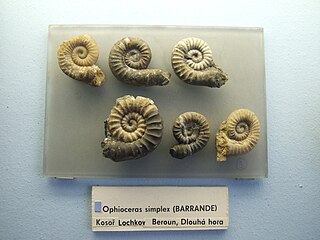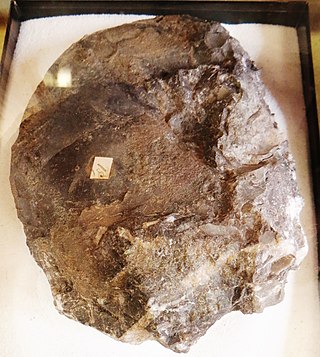
Aturia is an extinct genus of Paleocene to Miocene nautilids within Aturiidae, a monotypic family, established by Campman in 1857 for Aturia Bronn, 1838, and is included in the superfamily Nautilaceae in Kümmel 1964.
Acanthonautilus is an extinct genus in the nautilid family Solenochildae (Aipocerataceae) from the Upper Mississippian of North America and equivalent strata in Europe, first described by Foord in 1896.
The Tarphyceratidae are tightly coiled, evolute Tarphycerida with ventral siphuncles. The dorsum is characteristically impressed where the whorl presses against the venter of the previous. The Tarphyceratidae are derived from Bassleroceras or possibly from some member of the Estonioceratidae.

The Trocholitidae are Tarphycerida with whorls in close contact as with the Tarphyceratidae, but in which the siphuncle, similar in structure, becomes dorsal. The Trocholitidae are derived from the Tarphyceratidae, perhaps from different tarphyceratids.
Osbornoceras is a genus of Lower Silurian cyrtoconic nautiloid cephalopods known from Ohio and possibly Manitoba, one of five general currently included in the oncocerid family Karoceratidae.
Brevicoceras is an extinct nautiloid genus from the order Oncocerida with wide distribution in the Middle Devonian in Eastern North America, Russia and Morocco. Nautiloids form a broad group of shelled cephalopods that were once diverse and numerous but are now represented by only a handful of species in two genera.
Acleistoceras is a genus of the oncocerid, nautiloid family Acleistoceratidae that lived in the shallow seas that covered much of North America during the Devonian; living from 409—383.7 mya, existing for approximately 25.3 million years.
Solenochilus, type genus of the Solenochilidae is an extinct cosmopotilian nautilid from the Lower Pennsylvanian to the Lower Permian with a rapidly expanding, coiled globular shell with few whorls, from which prominent spines extend laterally from the umbilical area at maturity. Solenochilus is derived from the Upper Mississippian Acanthonautilus, principally through evolutionary changes in the siphuncle.
The Centroceratidae is the ancestral family of the Trigonoceratoidea and of the equivalent Centroceratina; extinct shelled cephalopods belonging to the order Nautilida
Mandaloceratidae is a family in the nautiloid cephalopod order Discosorida, from the Middle and Upper(?) Silurian characterized by short, essentially straight shells referred to as breviconic, typically with a faintly exogastric shape produced by the profile of the body chamber.
The Naedyceras group comprises three similar and closely related openly coiled, gyroconic, genera within oncocerid family, Brevicoceratidae: Naedyceras, Gonionaedyceras, and Gyronaedyceras.

Ophioceras is a genus of closely coiled tarphycerid nautiloid cephalopods, the sole representatives of the family Ophidioceratidae, characterized by an evolute shell with narrow, subrounded, annulated whorls and a subcentral siphuncle composed of thin connecting rings that show no evidence of layering. The mature body chamber is strongly divergent and is the longest proportionally of any tarphycerid. The aperture has a deep hyponomic sinus and ocular sinuses, and so resembles some lituitids.
Poterioceratidae is a family of nautiloid cephalopods included in the Oncocerida that lived during the period from the Early Devonian to the Early Carboniferous (Mississippian). Members of the Poterioceratidae are distinguished by a subcircular to compressed exogastric shell that has no hyponomic sinus and a central to subcentral siphuncle composed of subquadrate to nummuloidal segments in which the septal necks are more strongly curved on the upper, or dorsal side. This is opposite from the Karoceratidae in which siphuncle segments are inflated ventrally but straight dorsally. Some poterioceratid genera have actinosiphonate structures or annular deposits within the siphuncle. In others it is empty.
Simardoceras is a genus in the discosorid family Westonoceratidae from the Middle Ordovician of Quebec.
Valcouroceras is the type genus for the Valcouroceratidae, a family in the nautiloid order Oncocerida named by Rousseau Flower, 1943, named for Valcour Island in Lake Champlain, between New York state and Vermont, where it was first discovered.

Barrandeoceras is a large, coiled, Middle Ordovician nautiloid cephalopod and part of the Tarphycerida. The shell is serpenticonic with whorls touching but not embracing. The adult body chamber becomes freed of the preceding whorl, a rather common character among tarphycerids. Whorl section is oval, somewhat more narrowly rounded ventrally, on the outer rim, than dorsally, on the inner rim. Prominent lateral ribs, at least on inner whorls. Grow lines show a distinct hyponomic sinus. Sutures have lateral lobes. The siphuncle is subcentral.
Plectoceras is a genus of nautiloids included in the tarphycerid suborder Barrandeocerina that lived during the Middle and Late Ordovician. It has been found widespread in the Middle and Upper Ordovician of North America.

Alaskoceras is a genus of lower Ordovician coiled nautiloid cephalopods; the shell moderately expanded, ribbed, with a divergent living chamber; whorl section more broadly rounded ventrally than dorsally; siphuncle marginal at maturity, septal necks short, almost achoanitic; connecting rings thick, layered.
Tetrameroceras is a genus of short, essentially straight, breviconic, nautiloid cephalopods from the middle and Upper Silurian of Europe and North America included in the oncocerid family Hemiphragmoceraidae.

Maccoyoceras is a genus of nautilids included in the family Trigonoceratidae from the Mississippian of North America (Michigan) and Europe.





